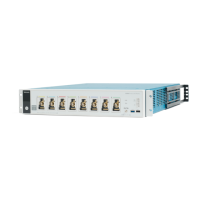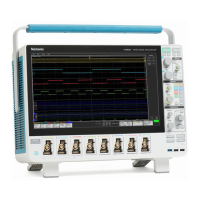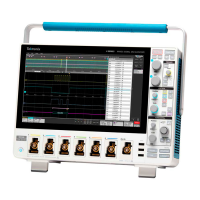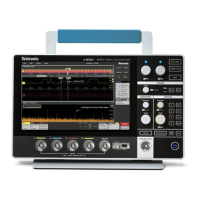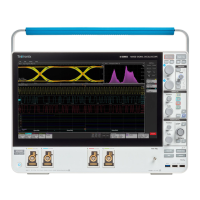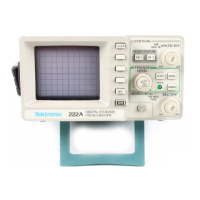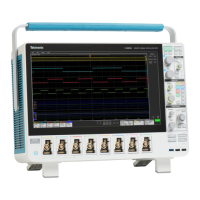12. Repeat steps 9 through 11 for each additional channel you want to deskew in the first set of four.
13. To deskew additional channels:
a. Disconnect all probe tips except the reference probe from the Probe Compensation connections.
b. Connect up to three probe tips and ground leads to the Probe Compensation connector (maximum of four channels at
a time).
c. Repeat steps 3 through 13 for the additional channels to deskew.
Deskew analog input channels - TEK-CDA method
To accurately minimize timing differences between probes using the optional TEK-CDA Compensation and Deskew Accessory,
see the TEK-CDA Compensation and Deskew Accessory Instructions.
Using the optional TEK-CDA accessory you can compensate and deskew probes.
Connect a keyboard or mouse
The instrument supports most standard USB-connected keyboards and mice, and wireless-connected keyboards and mice
(using a USB-connected dongle).
Connect a keyboard and/or mouse by connecting their USB cable, or USB dongle, into any available USB Host port. The
keyboard or mouse should work immediately. If it does not, try the following:
1. Remove and reinsert the USB cable or dongle in the same port.
2. Insert the USB cable or dongle into a different USB port.
Connect an external monitor or projector
Use the video outputs to send the instrument display to a projector or to a flat-panel LCD monitor.
1. Power on the oscilloscope.
2. Connect the appropriate video cable to the projector or monitor. Connect the other end to the correct DVI, Display Port, or
VGA connector on the oscilloscope.
3. Power on the projector or monitor.
4. Follow the projector or monitor instructions to set up and adjust the image.
Prevent ESD Guidelines
Electrostatic discharge (ESD) can damage oscilloscope and some probe inputs. This topic discusses how to avoid this type of
damage.
Electrostatic discharge (ESD) is a concern when handling any electronic equipment. The instrument is designed with robust ESD
protection, however it is still possible that large discharges of static electricity directly into the signal input may damage the
instrument. Use the following techniques to prevent electrostatic discharge from damaging the instrument.
■
Discharge the static voltage from your body by wearing a grounded antistatic wrist strap while connecting and disconnecting
cables, probes, and adapters. The instrument provides a ground connection to which to attach a wrist strap (on the Probe
Comp ground connector).
■
A cable that is left unconnected on a bench can develop a large static charge. Discharge the static voltage from all cables
before connecting them to the instrument or device under test by momentarily grounding the center conductor of the cable,
or by connecting a 50 Ω termination to one end, before attaching the cable to the instrument.
Configure the instrument
80 MSO54, MSO56, MSO58, MSO58LP, MSO64 Help
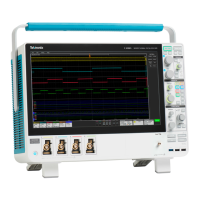
